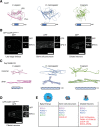A modified TurboID approach identifies tissue-specific centriolar components in C. elegans
- PMID: 35442950
- PMCID: PMC9020716
- DOI: 10.1371/journal.pgen.1010150
A modified TurboID approach identifies tissue-specific centriolar components in C. elegans
Erratum in
-
Correction: A modified TurboID approach identifies tissue-specific centriolar components in C. elegans.PLoS Genet. 2023 Feb 13;19(2):e1010645. doi: 10.1371/journal.pgen.1010645. eCollection 2023 Feb. PLoS Genet. 2023. PMID: 36780433 Free PMC article.
Abstract
Proximity-dependent labeling approaches such as BioID have been a great boon to studies of protein-protein interactions in the context of cytoskeletal structures such as centrosomes which are poorly amenable to traditional biochemical approaches like immunoprecipitation and tandem affinity purification. Yet, these methods have so far not been applied extensively to invertebrate experimental models such as C. elegans given the long labeling times required for the original promiscuous biotin ligase variant BirA*. Here, we show that the recently developed variant TurboID successfully probes the interactomes of both stably associated (SPD-5) and dynamically localized (PLK-1) centrosomal components. We further develop an indirect proximity labeling method employing a GFP nanobody-TurboID fusion, which allows the identification of protein interactors in a tissue-specific manner in the context of the whole animal. Critically, this approach utilizes available endogenous GFP fusions, avoiding the need to generate multiple additional strains for each target protein and the potential complications associated with overexpressing the protein from transgenes. Using this method, we identify homologs of two highly conserved centriolar components, Cep97 and BLD10/Cep135, which are present in various somatic tissues of the worm. Surprisingly, neither protein is expressed in early embryos, likely explaining why these proteins have escaped attention until now. Our work expands the experimental repertoire for C. elegans and opens the door for further studies of tissue-specific variation in centrosome architecture.
Conflict of interest statement
The authors have declared that no competing interests exist.
Figures




Similar articles
-
An acentriolar centrosome at the C. elegans ciliary base.Curr Biol. 2021 Jun 7;31(11):2418-2428.e8. doi: 10.1016/j.cub.2021.03.023. Epub 2021 Apr 1. Curr Biol. 2021. PMID: 33798427
-
Interactome analysis of Caenorhabditis elegans synapses by TurboID-based proximity labeling.J Biol Chem. 2021 Sep;297(3):101094. doi: 10.1016/j.jbc.2021.101094. Epub 2021 Aug 18. J Biol Chem. 2021. PMID: 34416233 Free PMC article.
-
Centrosome maturation requires phosphorylation-mediated sequential domain interactions of SPD-5.J Cell Sci. 2022 Apr 15;135(8):jcs259025. doi: 10.1242/jcs.259025. Epub 2022 Apr 20. J Cell Sci. 2022. PMID: 35362532
-
Centrosome size is controlled by centriolar SAS-4.Trends Cell Biol. 2003 Jul;13(7):340-3. doi: 10.1016/s0962-8924(03)00126-0. Trends Cell Biol. 2003. PMID: 12837604 Review.
-
Meet the neighbors: Mapping local protein interactomes by proximity-dependent labeling with BioID.Proteomics. 2016 Oct;16(19):2503-2518. doi: 10.1002/pmic.201600123. Epub 2016 Jul 27. Proteomics. 2016. PMID: 27329485 Free PMC article. Review.
Cited by
-
The development of proximity labeling technology and its applications in mammals, plants, and microorganisms.Cell Commun Signal. 2023 Sep 30;21(1):269. doi: 10.1186/s12964-023-01310-1. Cell Commun Signal. 2023. PMID: 37777761 Free PMC article. Review.
-
Correction: A modified TurboID approach identifies tissue-specific centriolar components in C. elegans.PLoS Genet. 2023 Feb 13;19(2):e1010645. doi: 10.1371/journal.pgen.1010645. eCollection 2023 Feb. PLoS Genet. 2023. PMID: 36780433 Free PMC article.
-
Nanobodies: From High-Throughput Identification to Therapeutic Development.Mol Cell Proteomics. 2024 Dec;23(12):100865. doi: 10.1016/j.mcpro.2024.100865. Epub 2024 Oct 19. Mol Cell Proteomics. 2024. PMID: 39433212 Free PMC article. Review.
-
Polycystins recruit cargo to distinct ciliary extracellular vesicle subtypes in C. elegans.Nat Commun. 2025 Apr 3;16(1):2899. doi: 10.1038/s41467-025-57512-3. Nat Commun. 2025. PMID: 40180912 Free PMC article.
-
A conserved protein tyrosine phosphatase, PTPN-22, functions in diverse developmental processes in C. elegans.bioRxiv [Preprint]. 2024 Mar 15:2024.03.12.584557. doi: 10.1101/2024.03.12.584557. bioRxiv. 2024. Update in: PLoS Genet. 2024 Aug 22;20(8):e1011219. doi: 10.1371/journal.pgen.1011219. PMID: 38559252 Free PMC article. Updated. Preprint.
References
Publication types
MeSH terms
Substances
Grants and funding
LinkOut - more resources
Full Text Sources
Miscellaneous

